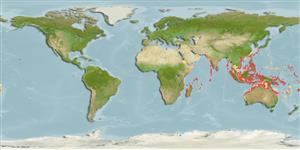Anthozoa |
Scleractinia |
Fungiidae
Environment: milieu / climate zone / depth range / distribution range
Ecology
Reef-associated; depth range 0 - 40 m (Ref. 847). Tropical; 32°N - 31°S, 34°E - 172°W (Ref. 847)
Indo-Pacific.
Length at first maturity / Size / Weight / Age
Maturity: Lm ? range ? - ? cm Max length : 75.0 cm TL male/unsexed; (Ref. 269)
Solitary, unattached coral found at all depths. The elongate colony has a thin furrow created by a series of corallites that run along the central axis. Colonies have a slightly rough surface, but appear neat due to the regular arrangement of petalloid septa, and may reach 75 cm in length (Ref. 269).
Zooxanthellae; free-living (Ref. 19).
Life cycle and mating behavior
Maturity | Reproduction | Spawning | Eggs | Fecundity | Larvae
Mature gametes are shed into the coelenteron and spawned through the mouth. Life cycle: The zygote develops into a planktonic planula larva. Metamorphosis begins with early morphogenesis of tentacles, septa and pharynx before larval settlement on the aboral end (Ref. 833).
Hodgson, G. 1998. (Ref. 269)
IUCN Red List Status (Ref. 130435)
CITES status (Ref. 108899)
Not Evaluated
Threat to humans
Human uses
| FishSource |
Tools
More information
Age/SizeGrowthLength-weightLength-lengthMorphologyLarvaeAbundance
Internet sources
Estimates based on models
Preferred temperature
(Ref.
115969): 25.2 - 29, mean 28 (based on 846 cells).
Vulnerability
Moderate to high vulnerability (50 of 100).
Price category
Unknown.
